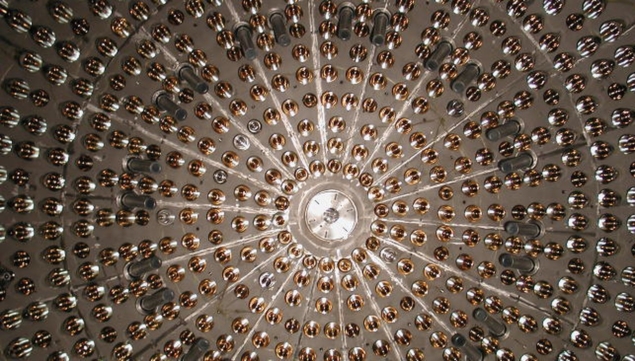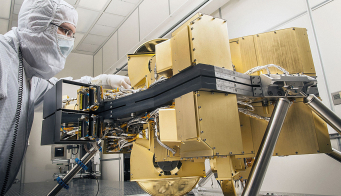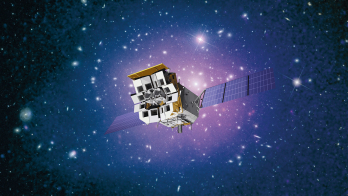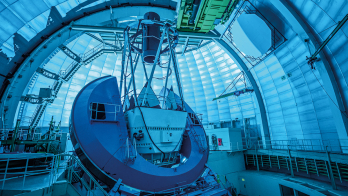
Despite being our closest star, much remains to be learned about the exact nature of the Sun and how it produces its energy. Two different fusion processes are thought to be at play in the majority of stars: the direct fusion of hydrogen into helium, which is thought to be responsible for approximately 99% of the Sun’s energy; and the fusion of hydrogen into helium via the six-stage carbon-nitrogen-oxygen (CNO) process (see diagram below). Although theorised in the 1930s, direct proof of this fusion process was missing. As a result, the amount of energy produced through the CNO cycle and the amount of elements such as carbon and nitrogen in the Sun’s core could only be estimated from models. Recently, the international Borexino collaboration directly detected neutrinos produced in the CNO cycle, providing the first direct proof of this process.
The Borexino detector was specifically developed to detect the extremely rare interactions between solar neutrinos and a highly pure liquid scintillator. It comprises 278 tonnes of scintillator held in a nylon balloon deep under the mountains at Gran Sasso National Laboratory in Italy. In 2012 the experiment detected neutrinos from the main solar fusion process. Now, one year before the end of its scheduled operations, the Borexino team has fully probed the solar energy production. The discovery of the CNO process was complicated both by the lower flux of neutrinos compared to that from the main fusion process, and by the large similarity between the signal and one of the main irreducible background processes taking place in the detector.

Battling background
Despite minimising backgrounds from cosmic rays, trace amounts of radioactive nuclei which leak into the active volume of Borexino produce a background of the same magnitude as the sought-after signal. The most important background for the CNO analysis was 210Bi, a product of 210Pb of which trace amounts can diffuse into the scintillator from the nylon balloon surface. Since the energy spectrum of the beta-decay of 210Bi resembles that induced by neutrinos produced in the CNO process, the key to detecting the CNO neutrinos was to directly measure the 210Bi-induced background. This was made possible by delving into the fluid dynamics of the liquid scintillator.
The 210Bi in Borexino’s scintillator produces 210Po, which undergoes alpha decay with a half-life of 134 days. As the alpha decay is relatively easy to identify, the team used 210Po decays to deduce the number of 210Bi decays in the detector. However, as the different isotopes move around in the liquid it cannot be guaranteed that the 210Bi distribution is equal to 210Po unless the flow in the detector is well understood. To overcome this, the collaboration had to reduce the flow of the scintillator material by stabilising the temperature, both through insulation and direct temperature regulation. After the 210Po decay distribution inside the detector was found to be stable over times exceeding its half-life, an area with low 210Po activity was identified and used to measure the CNO neutrinos with a well-understood and relatively low background.
This was made possible by delving into the fluid dynamics of the liquid scintillator
The spectral measurements performed of the CNO cycle exclude a non-detection with a statistical significance of more than five sigma. The measured solar-neutrino flux (7.2+3.0−1.7 counts per day per 100 tonnes of target, at 68% confidence) furthermore agrees with models which predict that 1% of the energy produced in the Sun comes from the CNO process. Additionally, the results shine light on the density of elements other than hydrogen and helium — the metallicity — of the Sun’s core, which in recent years has been debated to potentially differ from that on the solar surface. The Borexino results indicate that the density is likely similar although more precise measurements with future detectors are required for precision measurements.
This groundbreaking study, which required not only some of the most precise techniques used in particle physics but also complex fluid-dynamics simulations, confirms predictions made almost a century ago. In doing so it provides a first probe into the processes at the core of the Sun and thus of other stars. Although it has now been proved that the CNO process is responsible for only a fraction of the Sun’s energy, for heavier and therefore hotter stars it is predicted to be the dominant fusion process, making future high-precision studies important to understand the evolution of the universe in general.
Further reading
Borexino collaboration 2020 arXiv:2006.15115.







